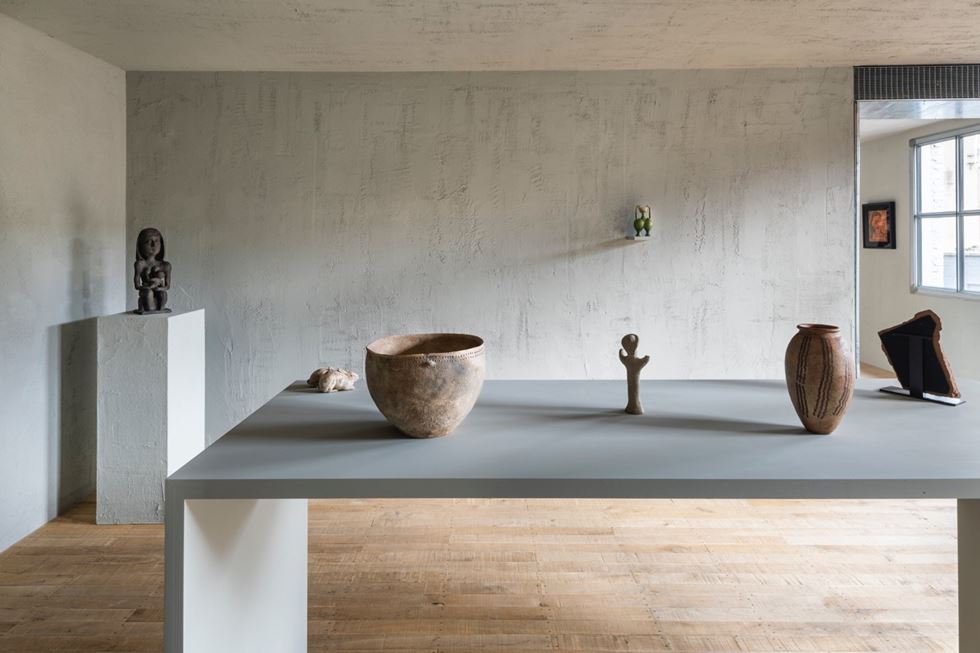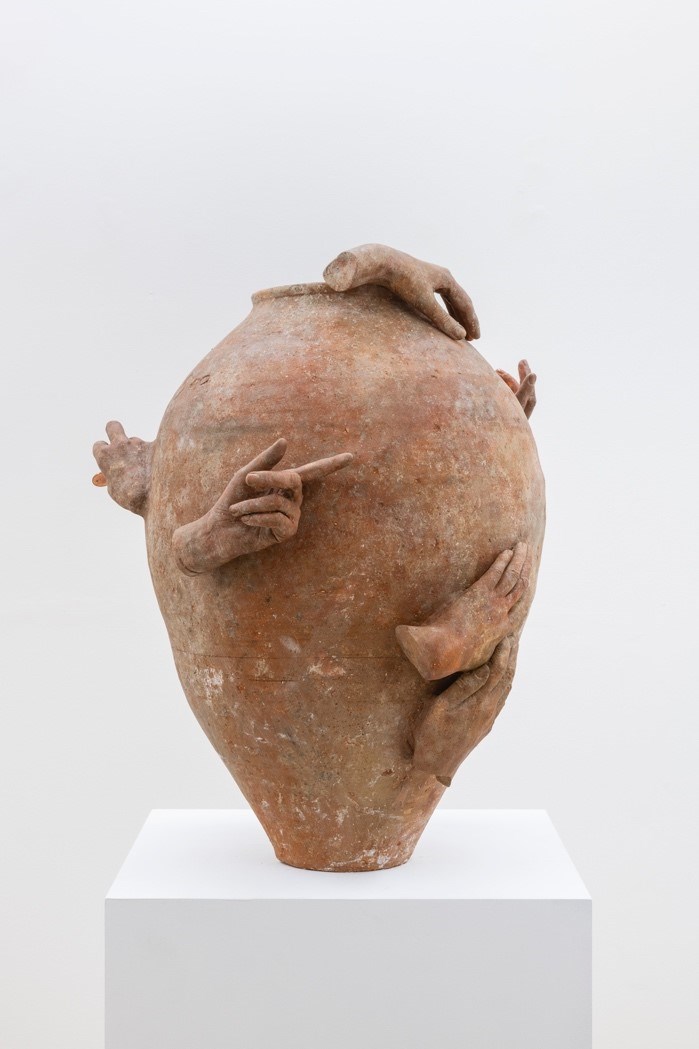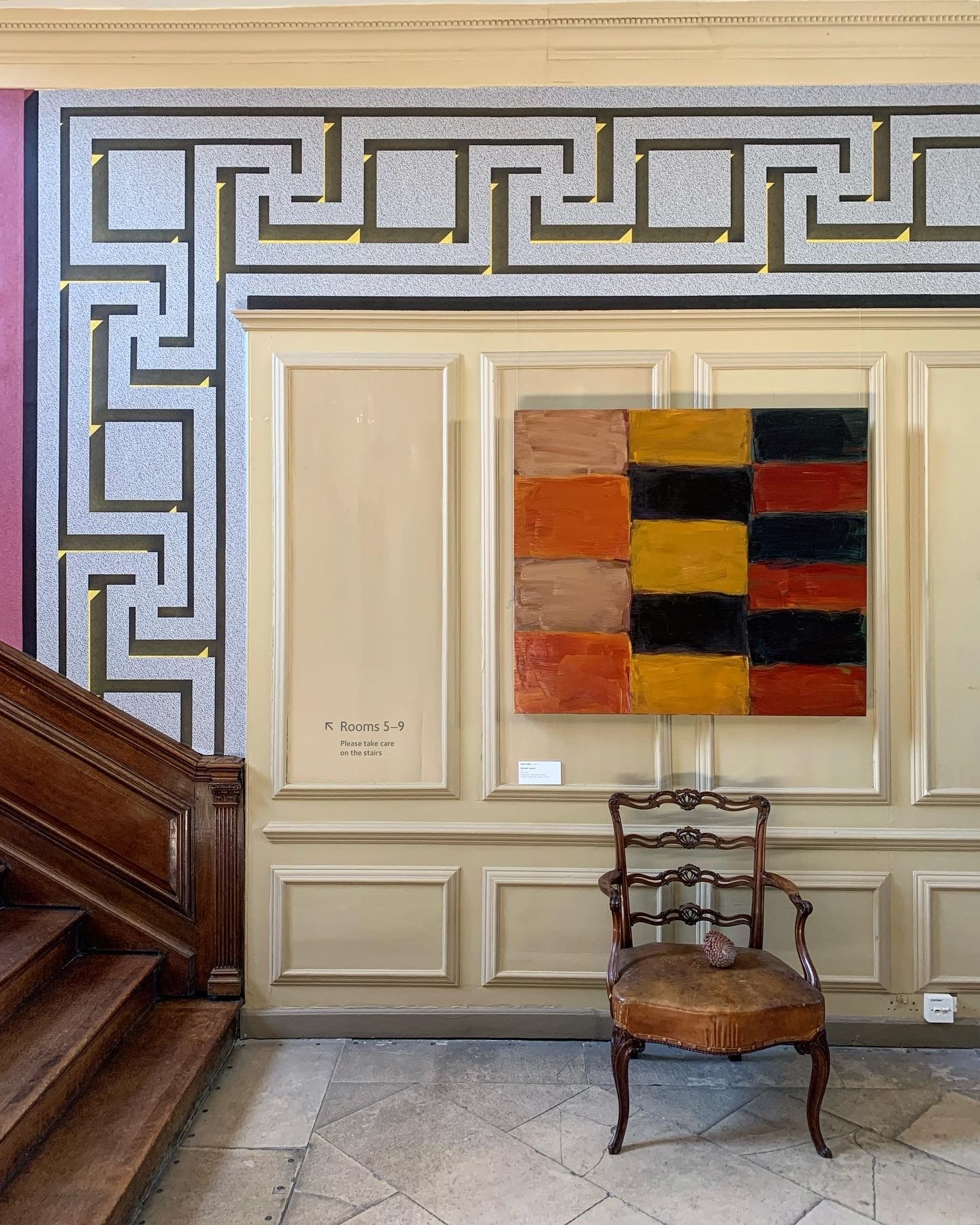Masterpiece Conversations | Modern & Contemporary Art

Ben Hunter in collaboration with Blue Projects, Terracotta at Blue Projects, Installation view. Photography by Damian Griffiths
Simon Martin is director of Pallant House Gallery, Chichester, where he has curated exhibitions on John Minton, Edward Burra, Eduardo Paolozzi and many others. He is also a trustee of the Charleston Trust.
Ben Hunter is the founder of the eponymous gallery in Duke Street, St James’s, specialising in 20th-century and contemporary art.
You both work with modern and contemporary art in your respective contexts. Did you make a conscious decision to span such a broad period?
Ben Hunter: One of the joys of owning a private art gallery is the ability to show art you love without necessarily having to fit into any particular category. It’s always interested me that, in the commercial art world, contemporary art seems to have this special place where it’s set apart – and if you do other things it’s perceived to be very broad. But if you were an Old Master paintings dealer, it wouldn’t be unusual to deal in works from the 16th to the 19th Century. To me, handling modern art and contemporary art together doesn’t really seem that broad. It’s very much guided by my taste and interest.
Simon Martin: For me, it’s closely related to how Pallant House Gallery and its collections have developed. Since 2006, when the extension to the 18th-century townhouse opened – a contemporary extension designed by Colin St John Wilson in association with Long & Kentish – the character of the building has been historic and modern. The collection is really a collection of collections, and its dominant character has always been 20th-century British, really from the 1920s through to the ’70s, in terms of what those original collectors bought. But in the early days of the reopening, after 2006, we didn’t want the historic house to feel like a National Trust property. And so, we started commissioning contemporary artists to create installations within the 18th-century townhouse.
That’s developed into a programme of contemporary artists engaging with our collection. One of the things that I’m very conscious of is that at the moment lots of contemporary artists are profoundly engaged with mid-century modern British art. That makes our job much easier in a way: the mediation of contemporary artists helps us make modern British art relevant and resonant to new audiences, and especially to younger visitors.

Interior of the Queen Anne townhouse at Pallant House Gallery with frieze designed by Pablo Bronstein In 2016, a chalk hearthstone created by Andy Goldsworthy in 2002 and ‘Blue, Black and White (1960-61) by Terry Frost. Photograph by Simon Martin, 2020.
Ben Hunter: The artists who I work with are deeply engaged with historical art and I’m always learning from them. A recent trip to Italy was transformed by conversations I had been having with Christopher Page about Roman wall painting. He opened my eyes to a type of image making I really knew very little about. After seeing those strange, illusionistic works in the flesh I became increasingly aware of how much of or world is mediated by visual artifice, particularly digitally. So the way artists can bring art history to life is very compelling and often much more about how we understand what is happening today than about looking backwards.
Looks at Clementine Keith-Roach’s practice, for example. Her deep understanding of baroque sculpture, of Greco-Roman antiquity and the legacy of the Surrealists is evident. And yet her works feel completely vital, alive and contemporary in their exploration of the body, of touch, of labour and its histories. They really capture a tension between old and new.
In terms of exhibitions, I’m not a curator: I work with a broad range of objects and often connections get teased out after works come together. I do think that there can be a danger of a primary dealer overusing historical material, because it inevitably becomes a lens through which to view the contemporary art, but if done sensitively, it can be very powerful.

Clementine Keith Roach, Manifold, 2019.Terracotta vessel, jesmonite, paint, copper coins.
H 67 x W 60 x D 50 cm. Photography by Damian Griffiths
The artists who I work with are deeply engaged with historical art and I’m always learning from them.
There are plenty of powerful players in these fields, whether major international institutions or, on the commercial side, a number of commanding galleries. How difficult is it to forge an original pathway?
Simon Martin: Creating a distinctive identity is challenging when every institution is trying to find a way of connecting with different audiences. One important thing for us is not to hold exhibitions that have been previously shown in London, because 20–25 per cent of our audience comes down from London to Chichester. When we held exhibitions of purely contemporary art the audience numbers dropped, I think largely because the metropolitan audience is so well-served with contemporary art by both commercial galleries and museums.
Instead, it’s been much more about creating a dialogue with the collection, about site-specific installations and trying to put on shows of artists who haven’t yet had an institutional exhibition. Our Nick Goss exhibition in 2019 is a good example: it could have been classed as a risk to give over our largest exhibition spaces to a contemporary painter, I suppose, but our visitors were fascinated by the selection Nick made of works by Michael Andrews, Edward Burra, Richard Hamilton and others to hang alongside his own paintings. He made visual and emotional connections that an institutional curator would not have made.
Ben Hunter: Rather than trying to force the issue of being different, I think it’s better to just trust your instincts. Personally I'm more interested in is introducing artwork and ideas to new audiences than actively trying actively differentiate myself. Collaboration is a great way to do that, and I regularly work with other dealers and artists to bring together different expertise and ways of working.
Earlier this year I collaborated on an exhibition of terracotta artworks and artefacts with Blue Projects. We exhibited material from antiquity to the present day at their space in Shoreditch where they’d previously only shown contemporary art. Their whole building makes reference to the hand-made – it’s got this beautiful interior with grey-plastered walls, very textured, and an amazing set of rooms showing art, furniture and design. I thought that the idea of terracotta, as a medium which is very tactile and has been used in the same way by artists since antiquity, fitted the ethos of the space. It was really interesting to show historical and contemporary material together in this context.

Ben Hunter in collaboration with Blue Projects, Terracotta at Blue Projects, Installation view. Photography by Damian Griffiths
Creating a distinctive identity is challenging when every institution is trying to find a way of connecting with different audiences.
How has the perception of modern British art changed in recent years?
Simon Martin: When I first started working at Pallant House Gallery, the field wasn’t at all fashionable. It was treated as something which was slightly provincial. What’s struck me in the last decade really, or the last 15 years, is how British artists are being taken very much more seriously on the international stage. Artists such as Richard Hamilton, David Hockney, Bridget Riley are truly international figures and have made a really significant contribution to the history of art.
Ben Hunter: I’d echo every word of that. Modern British art is increasingly global; modern British art is just modern art and British artists are being seen alongside their American and European contemporaries. Nevertheless, there’s still a way to go in terms of the market and I think this represents a great opportunity for collectors.
To what extent do museum professionals and the art trade currently share knowledge in this field?
Museums are absolutely vital to me in terms of understanding more about the context of the
work that I handle commercially.
Simon Martin: The commercial art trade and art institutions need to have a completely synchronistic relationship, I think. Every time we organise an exhibition I write to art dealers to ask for their assistance, not just for things like sponsorship but also in terms of finding the loans. We have to recognise that a lot of dealers really are experts and they have relationships with lots of collectors. And collectors trust them. They advise them. They help shape their collections.
I do have to smile sometimes when we do an exhibition of an artist and then, very soon after, that artist is having all kinds of commercial shows. It's inevitable in a way, and it’s quite a good thing to see – it proves that an exhibition brings artist to wider audiences and greater prominence.
Ben Hunter: Museums are absolutely vital to me in terms of understanding more about the context of the work that I handle commercially – from looking at specific objects, to the scholarship in museum catalogues, and how exhibitions recontextualise artists’ work.
Another angle is how important museums are to artists making art, in terms of commissions and exhibitions, or responding to a collection. There’s nothing more important for artists than to engage with museums. It’s vital for us as gallerists to have that discourse beyond our direct work as commercial entities.
How might the health crisis change your way of working in the long term?
Ben Hunter: I think everything will change – from how commercial galleries work with clients, museums and artists, to whether we do or don’t do art fairs and how we engage with digital. There’s no doubt that we’re all going to have to be creative in terms of showing art that we love and bringing that to the people who need to see it.
I also think the crisis presents an opportunity to make positive changes to our working practices going forward. We need to address the environmental impacts of our businesses and how we can do better. Technology will certainly play a role here and I think we will see an increasing focus on local or regional initiatives.
Simon Martin: It’s very difficult at this moment to judge what’s going to happen. For an institution such as Pallant House Gallery, our funding comes not just from ticket sales and public sources such as the Arts Council and our local council, but we have an endowment and are very dependent on our patrons and friends and on that endowment scheme. In the next financial year we’re likely to see a significant fall in the interest from our endowment investments (and of course our patrons will all be in similar situations). So there’ll be probably less money around in the long term. That will affect exhibitions and I think it will be harder to raise funds for acquisitions. But equally our relationships with art dealers, with artists and patrons are long-term relationships, and we are doing what we can to deepen those in the current moment and into the future.
We’re all going to have to focus a lot more on our immediate community programmes, to care for the more vulnerable and disadvantaged. Patrons will want to support that – they’ll see the value in it. I think as long as we can continue to show our relevance we should be OK.

Interior of the Queen Anne townhouse at Pallant House Gallery including Sean Scully’s Dark Pink Triptych (2011) and part of the Wall Pomp installation by Pablo Bronstein (2016). Photography by Simon Martin.
Ben Hunter: Is it exciting to have a period of time where you can maybe focus more on your collection?
Simon Martin: Yes. So often we’re focused on the exhibitions; from a communications perspective it’s almost like a hamster wheel when you’re trying to tell all these different stories. We took a decision very early on in this crisis not to focus on the exhibitions which were closed, which lots of institutions were doing, but actually to use this moment to talk about the collection, to talk about different stories, and I think people have really appreciated this ability to connect with the artworks in the collection when they cannot physically see them.
Please check your email and activate your account
Something went wrong



